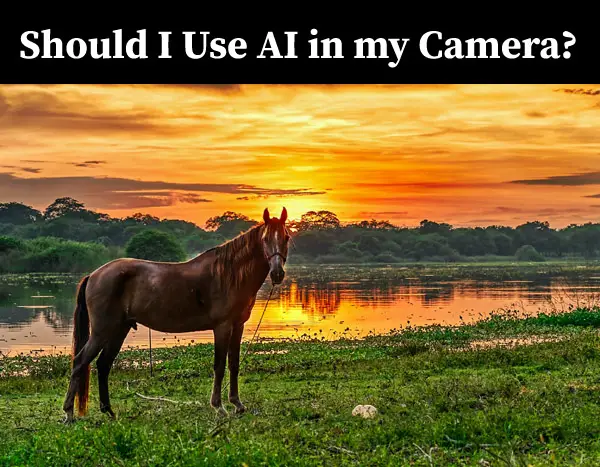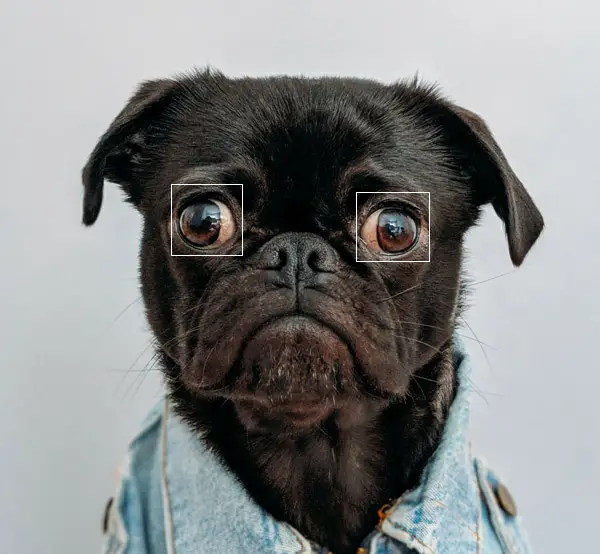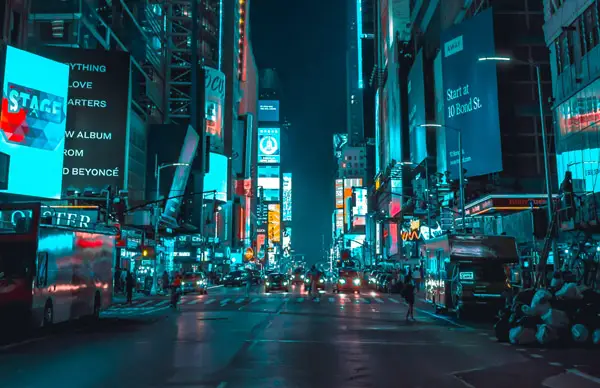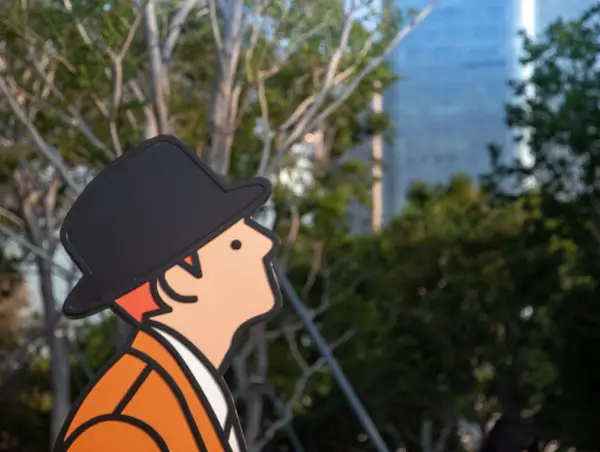Many photography enthusiasts lately find themselves asking- should I use the AI in my camera? The swift progression of tech has infiltrated the realm of photography, with AI at the leading edge of this revolution.

The introduction of AI in cameras promises to transform how we capture moments, promising superior image quality and ease-of-use. But what does it really mean for your photography journey?
If you’re asking yourself this question, let’s dive deeper into understanding what these smart cameras offer and how they can enhance your photographic experience.
Generally speaking, you should use the AI features in your camera, as they will save you time and improve the quality of your photos, in addition to allowing you to take images not possible without AI involvement. If you enjoy the process of taking a photo and want to have full control of every camera setting, you can always turn off the AI and work in manual mode.
Understanding the Concept of AI and AI Cameras
The domain of artificial intelligence (AI) is vast, with applications spanning numerous sectors. One area that has seen significant advancements due to AI implementation is photography through smart cameras.
AI denotes non-living systems that can sense their environment, analyze data, draw conclusions, and take action based on the info. These capabilities are facilitated by intricate algorithms embedded within these systems.
When we discuss photography in relation to artificial intelligence features or AI technologies, our attention turns towards AI cameras. Unlike traditional camera setups that require manual adjustments for optimal results, an AI camera employs machine learning and computer vision techniques to perform specific tasks more efficiently than humans alone.
Different Types Of Artificial Intelligence Programs
To fully understand how a smart camera operates using AI, let’s delve into three types: weak/narrow AI, general/broad-spectrum AI, and strong/full-scale AI.
Narrow/Weak AI: This form focuses on carrying out specific tasks proficiently, surpassing human abilities in those areas. It powers most modern-day DSLR or mirrorless models, allowing them to auto-adjust settings according to environmental conditions, ensuring optimized image capture effortlessly. An example would be smartphone cameras utilizing computational photography methods like HDR+ mode, where multiple shots taken at varying exposures are then combined into one high-quality photo using sophisticated image processing algorithms.
Broad-Spectrum/General AI: A step above narrow AI in terms of complexity, this version can handle any intellectual task just like a human being but isn’t yet widely implemented due to current technological constraints.
Full-Scale/Strong AI: The ultimate goal for many researchers in the field implies machines possessing consciousness similar to humans, enabling them not only to learn new things without prior programming but also to make independent decisions. However, this remains largely theoretical today, with no practical examples existing so far, despite the potential to significantly enhance photographic experiences, especially when effectively harnessed by advanced devices offering features like portrait mode, facial recognition, subject identification, among others.
Differentiating Factors Between Types Of AIs
While each type has its unique characteristics, they all play pivotal roles in various aspects related to computational photography through image processing algorithms.
This includes everything from adjusting exposure levels or identifying faces within frames faster than any human could possibly manage.
Key Features of AI Cameras
In the ever-changing landscape of photography, AI is having a major effect. The introduction and implementation of AI in cameras have brought about features that enhance image quality while simplifying the process for photographers.
The key attributes you’ll often find integrated into these smart camera systems include red-eye correction, facial recognition technology, subject identification capabilities, and digital zooming functions. Let’s explore each one further.
Red-Eye Correction: No More Glowing Eyes
A common issue faced by many photographers using flash is ‘red eyes’. This happens when light from a flash reflects off our retinas back to the lens causing an unnatural glow in subjects’ eyes. With the built-in red-eye correction feature found within most AI cameras today, this problem can be easily rectified without requiring any manual intervention. It enhances photo aesthetics significantly, saving time spent on editing work afterwards.
Facial Recognition Technology: Know Your Subjects Better
Moving onto another crucial component – Facial Recognition technology. In essence, it works by mapping out unique physical traits such as the distance between eyes or the shape of the chin, among others, which are then compared against stored data for matching purposes.
This sophisticated tech plays an integral role not only in personal but also security-based applications where swift identification may be critical in maintaining safety protocols.
Subject Identification: Beyond Faces
Beyond recognizing faces, some advanced AI cameras have evolved even further, identifying different types of subjects too. For instance, Canon EOS R6 and Nikon Z7 both offer animal face and eye detection, meaning if you’re photographing pets or wildlife, your device won’t just focus on getting clear shots, but it would understand what it’s capturing. The Sony A9 II and A6400 also have these features.

Digging Deeper Into Machine Learning And Computer Vision In Subject Recognition
Apart from identifying individual body parts such as the face or eyes, modern-day DSLR cameras employ sophisticated machine learning algorithms coupled with computer vision techniques for recognizing entire subjects, be it people, pets, objects, etc., thus allowing greater control over framing composition.
To illustrate further, consider photographing birds against a busy background full of trees. Traditional autofocus systems might struggle here because there isn’t enough contrast between your main subject (bird) and the surroundings (tree). But thanks to AI-based subject recognition technologies embedded in many high-end DSLRs today, these challenges become less daunting. These smart devices intelligently distinguish different elements present in any given scene based on patterns learned from thousands, if not millions, of similar scenarios encountered during training phases.
All said, impressive advancements have been made concerning eye detection and subject recognition in photography.
Nighttime Magic with AI Cameras
In the realm of night photography, artificial intelligence truly shines. Traditional cameras often fall short under low-light conditions due to issues like noise and camera shake. However, thanks to smart cameras powered by sophisticated AI algorithms, these challenges are now things of the past.

Noise reduction features integrated into these devices help eliminate unwanted graininess or speckles that tend to appear when photos are taken at high ISO settings or under poor lighting conditions. In addition, stabilization technologies ensure sharp shots even during handheld shooting sessions.
This means photographers can confidently venture out after sunset without worrying about lugging around heavy tripods or fiddling with complex manual settings. With advanced AI camera systems offering superior performance for nighttime photo shoots, they have become less daunting tasks and more exciting adventures.
A New Era: Computational Photography
Beyond enhancing traditional photographic techniques such as nighttime shooting, artificial intelligence also pioneers new ones – one notable example being computational photography. This innovative technique involves combining multiple photographs using cutting-edge image processing algorithms driven by machine learning capabilities inherent within powerful AI systems.
An excellent illustration would be HDR (High Dynamic Range) imaging where several pictures captured at different exposure levels merge into one single frame exhibiting greater dynamic range compared to any individual shot. Amazingly enough, this method is employed by some top-tier smartphone brands leveraging their state-of-the-art processors equipped with robust machine learning accelerators for real-time HDR recording sessions.
To put it simply, computational photography allows us not only to replicate human visual perception accurately but also to surpass what our eyes can see – enabling everyone from beginners to professionals to create extraordinary imagery previously unimaginable without extensive post-processing skills or expensive equipment.
Exploring Advanced Features Offered by Smart Cameras
The realm of smart cameras, brimming with AI technologies and advanced features, offers a transformative experience for photographers. These intelligent devices boast capabilities such as voice assistants that facilitate hands-free operation, multi-shot functionalities for capturing multiple images in quick succession, and augmented reality effects to add an artistic touch.
Voice Assistants
Voice assistant technology is rapidly gaining traction within the world of photography due to its convenience-enhancing properties. This feature allows you to adjust camera settings or initiate specific functions without having your fingers leave the shutter button – a boon when timing is crucial.
This isn’t merely limited to adjusting exposure values either; tasks like initiating video recording or triggering burst mode can be accomplished via simple verbal commands too.
Incorporating voice commands into operations allows photographers to manipulate their devices without physically interacting with buttons or dials, simply saying “Zoom”, “Capture”, or “Switch mode”. This is incorporated into GoPro and other cameras such as the ones on smartphones.
A Deep Dive Into Multi-Shot Capabilities
Beyond facilitating hands-free operations, artificial intelligence has also introduced multi-shot functionality into modern-day cameras – this involves taking several photographs at different exposures then combining them using computational photography techniques into one high-quality image.
- Apple’s iPhone 11 Pro Max uses this approach during Night Mode where it captures numerous photos at varying exposures before merging them together resulting in detailed low-light images free from excessive noise.
- Nikon’s D850 DSLR Camera utilizes focus stacking (a form of multishot technique) which takes multiple pictures focusing on different parts of the scene creating an end result that’s sharp across the entire frame.
Incorporating Augmented Reality Effects for Unique Imagery
Last but not least among these innovative features offered by smart cameras comes augmented reality (AR). AR overlays virtual elements onto real-world scenes offering unique visual enhancements making your work stand out from the crowd.

Take Google Pixel phones’ Playground app for instance; It provides users access to myriad fun AR stickers they could incorporate directly while shooting.
This kind of innovation gives both professionals and amateurs alike new avenues to explore their creativity within photographic endeavors.
Remember, each tool has its own advantages and drawbacks; thus, trying out different options is essential to find what fits best.
How Professionals And Amateurs Benefit From Using AI Cameras
The union of AI and photography has opened the door to a new age for photographers, regardless of their experience level. The use of AI camera systems not only simplifies the process but also enhances image quality significantly, in addition to making things faster.
Ai cameras are designed to analyze scenes, adjust settings according to subjects and lighting conditions automatically using complex algorithms. This level of automation liberates photographers from technical complexities, allowing them more freedom to focus on their creative vision while taking photos.
If you are worried that using AI in your camera may alter your photos too much, you can always shoot one version of a shot using AI features and one with all AI turned off. That way once you return home from your photo shoot or trip you will have both versions of the shot.
Compatibility With DSLR And Mirrorless Cameras
If you’re already an owner of older DSLR or mirrorless cameras, it’s important to note that compatibility with certain AI technologies may vary depending upon your device model as some might lack necessary hardware requirements needed by these intelligent systems.
An example is Arsenal – an advanced system offering state-of-the-art AI features such as automated scene recognition and optimal setting adjustments based on environmental factors like light intensity or subject movement. However, checking if your DSLR is compatible with Arsenal would be advisable before investing in this technology.
This addition can potentially enhance the performance capabilities of traditional cameras without requiring users’ extensive knowledge about intricate camera settings, making it accessible even for beginners who have just started exploring the world of photography.
Harnessing The Power Of AI In Photo Editing Software
AI photo editing software is transforming the realm of post-processing, thanks to machine learning algorithms. These intelligent tools automate various aspects of image enhancement and streamline workflows.
A perfect example that stands out in this domain is Luminar. This robust application employs artificial intelligence technologies for a range of tasks from noise reduction to sky replacement, making it possible even for novices to create striking edits with minimal effort.
Tackling Noise Reduction With AI
Noise reduction can be quite challenging when done manually. However, AI technology simplifies this process significantly while improving effectiveness. Luminar’s feature dedicated to noise removal utilizes an advanced algorithm that intelligently identifies unwanted digital “noise” and eradicates it without compromising essential details within your images.
Humans would struggle to achieve the same level of precision due to its complexity and laboriousness. But with artificial intelligence at work, you get superior results faster than ever before.
Sky Replacement Simplified By Artificial Intelligence Features
The power of AI photo editing software like Luminar also extends into replacing skies seamlessly in photographs. Traditionally, a complex task requiring expert-level skills now becomes as simple as selecting your desired sky from a library of options.
Leveraging sophisticated image processing algorithms along with machine learning capabilities, these programs accurately detect edges and match lighting conditions between foregrounds and backgrounds, ensuring seamless integration of the new element into the original photograph, resulting in realistic and breathtaking compositions every single time.
Capitalizing On Machine Learning For Advanced Image Enhancement
Beyond these features, many AI photo editing softwares offer other advanced functionalities powered by machine learning, including object removal and automatic color grading, among others, helping photographers achieve professional-grade results effortlessly, saving them valuable time and energy that could otherwise be spent on tedious manual adjustments, enhancing the overall enjoyment and reward derived from the entire process for all levels of users, from beginners to pros alike.
Future Prospects of AI in Photography
The future of AI in photography holds immense potential, with the anticipation of significant advancements and enhancements. As we continue to delve into artificial intelligence capabilities, it is anticipated that image processing algorithms will evolve dramatically.
This evolution could result in cameras automatically producing higher quality images without photographers needing to make manual adjustments. Moreover, subject recognition techniques are also expected to advance significantly, allowing cameras to identify and focus on subjects more accurately than ever before.
Promising Improvements in Image Processing Algorithms
In relation to image processing algorithms, there is a substantial scope for advancement. With further progressions in machine learning and computer vision technologies, these algorithms can be better trained over time by learning from both their mistakes as well as successes, which would lead towards progressively improved photos.
A case study worth mentioning here is Google’s super-resolution project. It utilizes an advanced form of AI technology known as deep convolutional networks (DCNs), enabling them to generate high-quality images even when starting with low-resolution inputs – hinting at what might become possible down the line if this level of sophistication was built directly into your camera.
Enhancements Expected in Subject Recognition Techniques
Moving forward, we can anticipate improvements within subject recognition techniques due largely to developments in facial recognition technology along with object detection capabilities driven by machine learning models such as YOLO (You Only Look Once).
IBM Watson Visual Recognition tool, for instance, has been making strides towards developing superior object detection abilities using deep learning models. This indicates how much room there still is for growth within the area, specifically photography, where accurate subject identification plays a crucial role.
Newer Applications and Features to Anticipate from AI Cameras
We are already witnessing some truly innovative features being introduced like voice assistants integrated directly into smart cameras and augmented reality effects made possible through computational photography techniques powered by AI systems. These are just scratching the surface though.
FAQs
Is an AI camera better?
An AI camera can enhance your photography experience with features like facial recognition, scene analysis, scene modes, and automated adjustments. It’s a game-changer for both amateurs and professionals.
What is the benefit of an AI camera?
The benefits of an AI camera include improved image quality, advanced subject recognition, automatic settings adjustment based on scenes, and enhanced post-processing capabilities.
Will AI affect photography?
Absolutely. From enhancing image quality to automating complex processes like noise reduction in night shots or multi-shot composition, artificial intelligence is revolutionizing photography.
Conclusion
Artificial intelligence in cameras is no longer a futuristic concept, but a reality that’s enhancing photography. From understanding the intricacies of AI and its role in smart cameras to exploring their advanced features, you’ve embarked on an enlightening journey.
The magic lies not just within the camera itself, but also in how it processes data and makes real-time decisions. Facial recognition, eye detection, or subject recognition – these are all key elements that come into play when we ask ourselves: Should I use AI in the camera?
You’ve seen how both professionals and amateurs can benefit from using AI-powered cameras. The compatibility with DSLR and mirrorless systems further broadens the horizon for creative possibilities.
AI doesn’t stop at capturing images; it extends to post-processing too. Powerful editing software like Luminar harnesses machine learning algorithms to take your photos up several notches.
The future prospects of AI in photography seem promising with potential advancements on the horizon. As technology evolves, so will our ability to capture stunning images effortlessly. Click the following link to learn how to focus stack manually.








